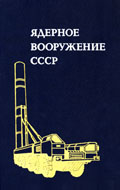About the project
The goal of the project is to provide Russian citizens and policy makers with information about nuclear weapons, arms control and disarmament based on open scientific analysis.
The first Russian-language source of information about Soviet nuclear forces
The Russian Nuclear Forces Project started in 1991 by a group of young Russian scientists at the Center for Arms Control Studies. At that time, there was virtually no information about the Soviet nuclear weapons available to the Russian public. The little information that was available to researches drew on foreign-language sources that were not easily accessible. The Russian Nuclear Forces Project included translating into Russian and publishing in the Soviet Union "Soviet Nuclear Weapons," the book originally published in the United States by the Natural Resources Defense Council in 1988 as part of their Nuclear Weapons Databook series (Nuclear Weapons Databook: Volume IV. Soviet Nuclear Weapons, by Thomas B. Cochran, William M. Arkin, Robert S. Norris and Jeffrey I. Sands). It was the most authoritative open source of detailed information about the Soviet nuclear weapons available at that time.
The Russian translation of the NRDC Databook volume, which was published in Moscow in 1992, became the first ever Russian-language book in open circulation that described the Soviet nuclear arsenal.
 |
Yadernoye vooruzheniye SSSR
T. Cochran, W. Arkin, R. Norris, J. Sands P. L. Podvig, editor of the Russian translation Moscow, IzdAT, 1992 460 pages, illustrations ISBN 5-86656-033-X |
The book was translated into Russian with help from Janna Bogachenko, Oleg Bukharin, Peter Emelianov, Timur Kadyshev, Svetlana Kazmina, Oleg Kazmin, Nikolai Kukharkin, Andrei Pochinski, Michail Stepanov, Maxim Tarasenko, and Vladimir Tarasyuk. Pavel Podvig was the editor of the translation and the principal investigator of the project. The financial support for the publication was provided by the Natural Resources Defense Council.
The first detailed open Russian account of the nuclear complex
Inspired by the success of the translation of the "Soviet Nuclear Weapons", the group at the Center for Arms Control Studies decided to produce a book that would be similar to the American volume, but would be based on Russian sources and provide up-to-date and accurate information about the state of the Russian nuclear forces and the industrial infrastructure that supports it.
The research for the book began in 1996. The working group included Oleg Bukharin of the Center for Energy and Environmental Studies at the Princeton University, Boris Zhelezov and Igor Sutyagin of the U.S. and Canada Institute of the Russian Academy of Sciences, and Timur Kadyshev, Eugene Miasnikov, Pavel Podvig, and Maxim Tarasenko of the Center for Arms Control Studies at the Moscow Institute of Physics and Technology. The group was headed by Pavel Podvig, who was the principal investigator of the project and the editor of the book.
The research work and the publication of the book were supported by the Ploughshares Fund and the W. Alton Jones Foundation. The research project was also supported by the John Merck Fund.
 |
Strategicheskoye yadernoye vooruzhenie Rossii
Edited by P. L. Podvig O. A. Bukharin, B. V. Zhelezov, T. T. Kadyshev, E. V. Miasnikov, P. L. Podvig, I. V. Sutyagin, M. V. Tarasenko Moscow, IzdAT, 1998 492 pages, illustrations ISBN 5-86656-079-8 |
In November 1998 the group unveiled the result of their work—the book "Strategicheskoye yadernoye vooruzhenie Rossii," which became the first open Russian account of the history and structure of the Soviet/Russian nuclear complex. The book brought together most of the information about Soviet and Russian nuclear weapons that was available at the time, and presented it in a concise and organized form. All the information in the book was collected from open, primarily Russian sources. The authors have always considered this to be the most the most important aspect of their work.
The unique character of the book made it very successful in Russia and elsewhere. The book was especially popular with the military, Minatom, and the experts who work on military issues.
Unfortunately, the idea of open academic research on matters related to military policy and national security is still treated in Russia with suspicion. In October 1999, the Federal Security Service (the FSB, formerly the KGB) seized all undistributed copies of the book alleging that it divulges state secrets. These allegations are, of course, absolutely groundless. In May 2002, the FSB admitted this fact by returning all seized copies of the book as well as all computers and working materials.
The book is now available in English
The work on English edition of the book began almost immediately after its publication in Moscow. Although the English edition is mostly a translation of the Russian text, it was updated to reflect the changes in the Russian nuclear complex and strategic forces in recent years. This work was done primarily by Pavel Podvig, who also wrote the afterward summarizing the recent developments.
 |
Russian Strategic Nuclear Forces
edited by Pavel Podvig with contributions from Oleg Bukharin, Timur Kadyshev, Eugene Miasnikov, Pavel Podvig, Igor Sutyagin, Maxim Tarasenko, and Boris Zhelezov The MIT Press 7x9, xxii, 693 pages, 57 illustrations ISBN 0-262-16202-4 hardcover ISBN 0-262-66181-0 paperback |
The research project that allowed keeping the book up-to-date was supported by the John Merck Fund. The translation and publication of the book were supported by the Security Studies Program at the Massachusetts Institute of Technology with a grant from the W. Alton Jones Foundation.
